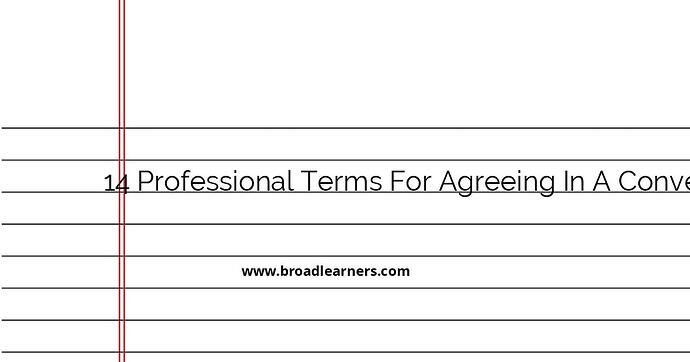When engaging in professional conversations, it is important to express agreement in a professional and respectful manner. Using appropriate terms can help convey your agreement while maintaining a professional tone. Here are 14 professional terms for agreeing in a conversation:
- I agree
- Definitely
- Absolutely
- Without a doubt
- For sure
- Certainly
- Indeed
- Agreed
- That's right
- Exactly
- True
- That makes sense
- Good point
- I couldn't agree more
Let's explore each term in more detail:
1. I agree
This is a straightforward and simple way to express agreement. It shows that you are on the same page as the other person.
Example:
Colleague A: I think implementing this new strategy will improve our productivity.
Colleague B: I agree. It seems like a promising approach.
2. Definitely
By using “definitely,” you confirm your agreement with confidence. It emphasizes that you have no doubts about what the other person said.
Example:
Colleague A: We should consider investing in this software. It will streamline our processes.
Colleague B: Definitely. It will help us become more efficient.
3. Absolutely
This term emphasizes strong agreement. It conveys that you are fully supportive of the idea or statement.
Example:
Colleague A: We need to prioritize customer satisfaction above everything else.
Colleague B: Absolutely. Customer satisfaction should be our top priority.
4. Without a doubt
By using “without a doubt,” you express complete certainty and agreement. It implies that there is no room for disagreement.
Example:
Colleague A: This new marketing campaign will attract a larger audience.
Colleague B: Without a doubt. It's a well-designed campaign.
5. For sure
This term indicates agreement with a sense of certainty. It suggests that you are confident in your agreement.
Example:
Colleague A: We should proceed with this partnership. It aligns with our long-term goals.
Colleague B: For sure. It's a strategic move for our company.
6. Certainly
Using “certainly,” you express agreement in a polite and formal manner. It conveys that you are in complete agreement.
Example:
Colleague A: We should consider offering flexible work hours for our employees.
Colleague B: Certainly. It can improve work-life balance.
7. Indeed
This term emphasizes strong agreement. It suggests that you wholeheartedly endorse the statement or idea.
Example:
Colleague A: This new product will revolutionize the industry.
Colleague B: Indeed. It has unique features that set it apart.
8. Agreed
By simply stating “agreed,” you acknowledge your agreement and indicate that you are aligned with the other person's perspective.
Example:
Colleague A: We should prioritize innovation to stay ahead of the competition.
Colleague B: Agreed. Innovation is crucial for our success.
9. That's right
This term expresses agreement and confirms that the other person's statement is accurate or correct.
Example:
Colleague A: This report shows a clear upward trend in sales.
Colleague B: That's right. Our sales have been consistently increasing.
10. Exactly
By using “exactly,” you indicate precise agreement. It shows that you share the same viewpoint as the other person.
Example:
Colleague A: We need to focus on improving our customer service quality.
Colleague B: Exactly. It will enhance our brand reputation.
11. True
By saying “true,” you validate the other person's statement and express agreement. It implies that you recognize the validity of what was said.
Example:
Colleague A: We should prioritize employee growth and development.
Colleague B: True. It's important for employee satisfaction and retention.
12. That makes sense
This term conveys agreement and indicates that the other person's statement or idea is logical and reasonable.
Example:
Colleague A: We should allocate more resources to market research.
Colleague B: That makes sense. It will help us make informed decisions.
13. Good point
By acknowledging a “good point,” you indicate agreement and recognize the validity of the other person's argument or perspective.
Example:
Colleague A: We should consider customer feedback for product improvements.
Colleague B: Good point. It's essential to listen to our customers.
14. I couldn't agree more
This phrase emphasizes strong agreement. It conveys that you fully support and endorse the other person's statement or idea.
Example:
Colleague A: We need to prioritize workplace diversity and inclusion.
Colleague B: I couldn't agree more. Diversity drives innovation and fosters a positive work environment.
Using these terms can help you express professional agreement in a variety of professional settings. Remember to consider the context and tone of the conversation to choose the most appropriate term to convey your agreement.
Did I miss anything? Respond below
